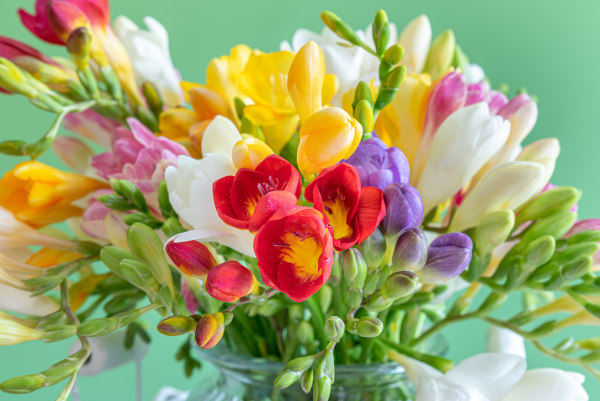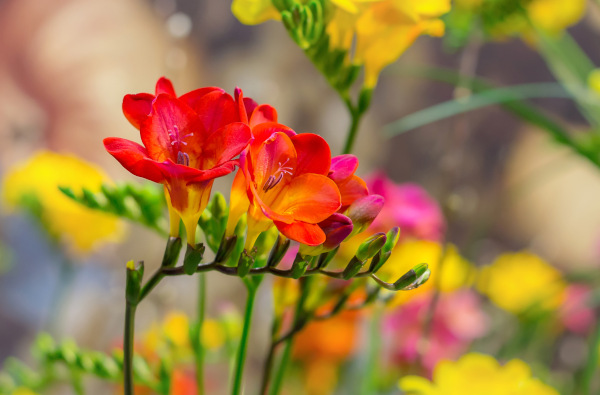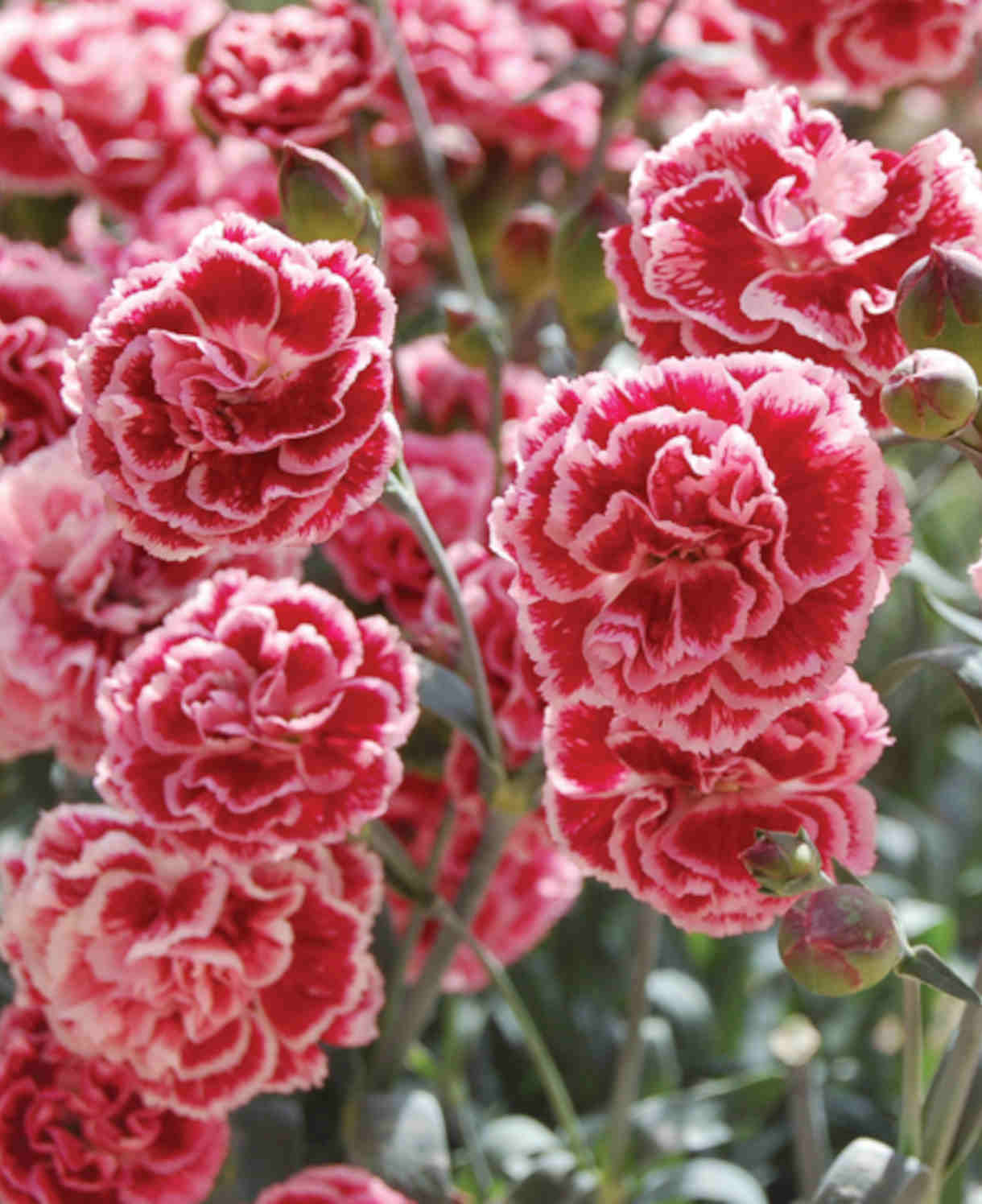How to grow Freesia
Freesias are one of the worlds most popular cut flowers, loved for their broad range of colours, long stems, and strong scents. A member of the Iris family, Freesias are herbaceous cormous perennials, native to South Africa where they are winter flowering plants.
Over 300 cultivars have been developed for use within the cut flower industry, owing to their exceptionally long-lasting, colourful, and highly scented blooms, which are large and funnel-shaped, held in dense racemes on arching, branched stems.
The foliage grows in pointed straps giving way to elegant stems which make a beautiful display in sunny borders near seating areas where their fragrance can truly be appreciated.

Key Information
Soil pH
Position
Hardiness


Where & when to plant Freesia
In warmer parts of the UK, Freesias can be planted in the spring when any danger of frost has passed, ready to flower from August to September. For a higher rate of success, corms are usually heat treated to mimic the hot South African summers. Quite often this results in corms only having one true season and therefore are unofficially used as Annuals in some cooler regions of the UK where winter temperatures often drop below 5°C.
Freesias prefer moderately fertile but well drained soils in spots where they will receive much of the day’s sunlight. Should you choose unprepared corms and live in a mild region, plant outside in August or September for flowers the following spring.
How to plant Freesia
When buying your corms, it is our recommendation that you buy them as soon as you see them in shops to avoid picking up corms which are past their best from sitting on the shelf for too long. Look through the packaging where possible to ensure the corm looks fresh and light in colour. Check for the size of the corm, bigger corms will produce more flower spikes. Last but definitely not least, check for firmness. If the corm feels softer than the centre of your palm, then we would suggest you look for another pack.
Plant corms 5cm deep and 5-8cm apart with the pointy end of the bulb pointing upwards into a most and free draining soil or compost. ‘Firm’ the corms in using your knuckles to remove air pockets. Water once to wake them up and then water sparingly through the winter to avoid rot.

What to plant with Freesia
Ranunculus
Pair with Spring flowering Ranunculus for a truly vibrant Easter display. Plant on masse interspersed with evergreens that need a little colour boost to show off their unique topiary shapes. Ranunulcus would work well in a mixed planter on the patio or in the border where their zesty colours can really pop out.
Dianthus
Dianthus are evergreen perennials with a clump forming habit, available in a range of heights and spreads depending on which variety they choose. The Dianthus should be just ramping up by the time your Freesia. Dianthus would work well with Freesias as part of a mixed planter or as a harmonious accompaniment in the borders. Dianthus are also lightly scented.
Primroses and Primulas
Primroses and Primulas are excellent perennials to plant underneath taller neighbouring plants. They form a beautiful carpet and naturalise easily whilst providing good cheer in the early months of the year. As both Freesias and Prims come in a range of colours it should be vary simple to find a colour scheme that works for you and your garden. Primroses also work well in a variety of containers and are very easy to maintain.
Pulmonaria
Pulmonaria are beautiful gentle little additions to the border, they never fail to bring a smile. The ease into any open gaps and are a magnet for early rising bees. Pulmonarias typically come in shades of blue and white and flower when all the other plants in your garden are just thinking about waking up.



How to care for Freesia
Pruning and Deadheading
Deadhead as required, cutting spent flower stalks down to the ground.
Leave foliage to die back naturally, only removing once yellow and withered. This allows the corm to store enough energy to power growth and flowering the following year.
Watering
Keep soil or compost consistently moist throughout the growing season, allowing the top few centimetres to dry out between soakings.
Cold Protection
Freesias are half-hardy, and therefore (much like dahlias) need to be lifted and stored over winter. Unlike dahlias, however, freesias flower best following warm storage. The ideal is 26°C. Often the best place to achieve this is in an airing cupboard, or perhaps a heated conservatory.
In autumn, dig up corms, shake and rinse off all soil or compost, and allow to dry out. Remove old, shrivelled parts and keep only the healthy, plump-looking corms, placing them in a paper bag. Store in a warm environment as described above. Take out in January and, whether you pot up and start into growth or continue to store as bare corms until planting out in May, keep in a cool, frost-free environment.
The corms will need a drop in temperature (though not below freezing!) to trigger them into growth, which is why we don’t recommend leaving them in warm storage right up until May.
Cool winter storage or even leaving corms in the ground with a thick layer of dry mulch can both work, though are unlikely to result in as long and floriferous display as the heat treatment.
For a lower effort option, treat your freesias as annuals and replace with new corms each spring.
Pests and Diseases
Outdoors, freesias tend to be trouble-free.
Indoors, the usual issues of spider mite and aphid can crop up. Keeping indoor plants as healthy as possible is the key to warding off problems, and by this we mean proper ventilation, adequately spaced plants (for good air flow), keeping everything well-watered and fed, and repotting into larger containers when necessary. Thoroughly cleaning the indoor environment every winter can also help to remove overwintering populations of pests.
Where infestations do take hold, try introducing biological controls (often sachets or tubes containing miniscule natural predators), or in the worst cases, remove the affected plant/s altogether.
How to propagate Freesia
Freesia can be propagated by separating offsets (baby corms which form on the ‘mother’ corm). This should be done when the plant has entered dormancy in autumn.
- Once you are certain your freesia is dormant (indicated by withered, yellow foliage), carefully use a fork to lift corms out of the ground.
- Shake and rinse off any soil.
- Gently tease away any offsets which have formed around the main corm.
- Place both offsets and larger corms in a cool, dry place for a few weeks to allow them to fully dry out.
- Place in a paper bag.
- Store in a warm environment as explained in the ‘Cold Protection’ section above.
- Pot or plant the following year as described in the ‘When and where to plant freesia’ and ‘How to plant freesia’ sections.




